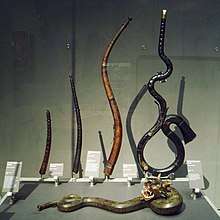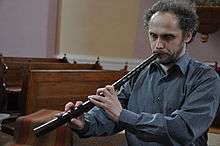Cornett
The cornett, cornetto, or zink is an early wind instrument that dates from the Medieval, Renaissance and Baroque periods, popular from 1500 to 1650.[1] It was used in what are now called alta capellas or wind ensembles. It is not to be confused with the trumpet-like cornet.

The sound of the cornett is produced by lip vibrations against a cup mouthpiece. A cornett consists of a conical wooden pipe covered in leather, is about 24 inches (60 cm) long, and has finger holes and a small horn, ivory, or bone mouthpiece.
Construction
The ordinary treble cornett is made by splitting a length of wood and gouging out the two halves to make the gently conical, curved bore. The halves are then glued together, and the outside planed to an octagonal cross section, the whole being bound in thin black leather. Six front finger holes and a thumb hole on the back (like on the recorder) are bored in the instrument, and are slightly undercut. The socket for the mouthpiece at the narrow end is reinforced with a brass with pp collar, concealed by an ornamental silver or brass mount. The separate cup mouthpiece is usually made of horn, ivory, or bone, with a thin rim and thread-wrapped shank. Because it lacks a little-finger hole at the bottom, its lowest note is the A below middle C, though another tone lower could be produced by slackening the lips to flatten the note.[2]
At least three existing specimens of bass cornett reside in the collection of the Musée de la Musique, Paris (see "external links" below).
Music for the cornett
Historically, two cornetts were frequently used in consort with three sackbuts, often to double a church choir. This was particularly popular in Venetian churches such as the Basilica San Marco, where extensive instrumental accompaniment was encouraged, particularly in use with antiphonal choirs. Giovanni Bassano was a virtuoso early player of the cornett, and Giovanni Gabrieli wrote much of his polychoral music with Bassano in mind. Heinrich Schütz also used the instrument extensively, especially in his earlier work; he had studied in Venice with Gabrieli and was acquainted with Bassano's playing.
The cornett was, like almost all Renaissance and Baroque instruments, made in a complete family; the different sizes being the high cornettino, the cornett (or curved cornett), the tenor cornett (or lizard) and the rare bass cornett. The serpent largely supplanted the bass cornett in the 17th century. Other versions include the mute cornett, which is a straight narrow-bore instrument with integrated mouthpiece, quiet enough to be used in a consort of viols or even recorders.
The cornett was also used as a virtuoso solo instrument, and a relatively large amount of solo music for the cornetto (and/or violin) survives. The use of the instrument had declined by 1700, although the instrument was still common in Europe until the late 18th century. Johann Sebastian Bach, Georg Philipp Telemann and their German contemporaries used both the cornett and cornettino in cantatas to play in unison with the soprano voices of the choir. Occasionally, these composers allocated a solo part to the cornetto (see Bach's cantata O Jesu Christ, meins Lebens Licht, BWV 118). Alessandro Scarlatti used the cornetto or pairs of cornetts in a number of his operas. Johann Joseph Fux used a pair of mute cornetts in a Requiem. It was scored for by Gluck, in his opera Orfeo ed Euridice (he suggested the soprano trombone as an alternative) and features in the TV theme music Testament by Nigel Hess, released in 1983.
History

The cornett in its current form was developed in the late 15th or early 16th centuries, as an improvement over earlier designs of horn that had been around since at least the medieval era. These early instruments were played with one hand covering four or fewer fingerholes and the other stopping the bell to create additional tones, much like on a French horn. In Northern Europe, these horns, referred to in Scandinavian languages as bukkehorns, were made from natural animal horns, whereas similar instruments from central Europe were made from wood turned on a lathe; the fusion of these two instrument-building traditions as the cornett advanced in melodic capability explains the coexistence of the straight and curved cornetts, with the form of the latter most likely being a skeuomorphic trait derived from animal horns.[3]
Playing the cornett

"At every stage of its development the cornett was an instrument of professional musicians."[4]
The cornett is generally agreed to be a difficult instrument to play—it requires a lot of practice. It embodies a design that survives today in the Russian Vladimir horn or rozhok. The main tube has only the length of a typical woodwind, but the mouthpiece is of the brass type, relying on a combination of the player's lips and the alteration of the length of the sound column via the opening and closing of the finger holes to alter the pitch of the musical sound. Most modern brass instruments are considerably longer than the cornett, which permits the use of harmonics, the sound being altered by slides or valves to control the pitch.
The Baroque era was relatively tolerant of bright or extroverted tonal quality, as the surviving pipe organs of the time attest. Thus the Baroque theorist Marin Mersenne described the sound of the cornett as "a ray of sunshine piercing the shadows". Yet there is also evidence that the cornett was sometimes badly played, although it also seems to have been played much more expertly than any other woodwind instrument. Its upper register sounded somewhat like a trumpet or modern cornet, the lower register resembling the sackbutts that often accompanied it. Cornett intonation is flexible, which enabled it to be played perfectly in tune in a range of tonalities and temperaments.
As a result of its design, the cornett requires a specialized embouchure that is, initially, tiring to play for any length of time. Violins often replaced cornetts in consort music, and cornetts similarly substituted for violins in consort music and sacred music. The cornett and violin were considered interchangeable; and a good cornettist doubled between either cornetts and trumpets or cornetts and recorders.
Cornetts were used to reinforce the human voice in choirs, and many commentators suggested that the sound of a well-played cornett, heard at a distance, could be mistaken for a "choice castrato". The place of the cornett was never really filled by any other instrument and it was not until the second half of the 20th century that the cornett revival gave music lovers a chance to hear the sound of this instrument again in its proper context.
The cornett and authentic performance
As a result of the recent historically informed performance movement the cornett has been rediscovered.[5] The violin was the usual substitute for the cornetto in historical music. The recorder, modern B♭, C, or D trumpet, oboe, and soprano saxophone have all been used as substitutes for the cornett in modern performances.
References
- "Zink". Dictionary.com. Retrieved 2012-05-26.
- Anthony Baines, Woodwind Instruments and Their History, with a foreword by Sir Adrian Boult (New York: W. W. Norton & Company, Inc, 1957): 259–60.
- Knock, Jarratt. "THE 'CORNETT': DIVERSITY OF FORM, FUNCTION AND USAGE AS PORTRAYED IN ORGANOLOGICAL AND ICONOGRAPHICAL SOURCES, c.1500- c.1800" (PDF). Birmingham University. Retrieved 22 June 2020.
- Dickey, Bruce (1997). "The cornett". In Herbert, Trevor; Wallace, John (eds.). The Cambridge Companion to Brass Instruments. Cambridge Companions to Music. Cambridge University Press. p. 62.
- Carter, Stewart; Kite-Powell, Jeffery, eds. (2012). "6: Cornett and Sackbut". A performer's guide to seventeenth-century music (2nd ed.). Bloomington: Indiana University Press. pp. 100–118. ISBN 978-0253357069.
External links
| Look up cornett in Wiktionary, the free dictionary. |
| Wikimedia Commons has media related to Cornetts. |
- The French Wikipedia cornett page shows photos of two existing specimens of the bass cornett
- A third bass cornett in the collection of the Musée de la Musique, Paris
- A page about the cornett
- Christopher Monk Instruments, one of the more well-known modern makers of cornetts
Extant cornetts at The Metropolitan Museum of Art
Modern performance
- L'Arpeggiata with Christina Pluhar as conductor, (winner of the 2010 Dutch Edison) makes use of one or two cornetts
- City of Lincoln Waites (The Mayor of Lincoln's own Band of Musick)
- Concerto Palatino, a leading ensemble centered on the cornetto and trombone and directed by Bruce Dickey and Charles Toet.
- The English Cornett and Sackbut Ensemble, a performance group that makes use of the cornett
- Ensemble La Fenice, A French period performance group directed by cornettist Jean Tubery.
- His Majestys Sagbutts & Cornetts (est. 1982), the pre-eminent, internationally renowned British cornett and sackbut ensemble.
- Johann Rosenmüller Ensemble, a performance group directed by the German cornetto player Arno Paduch
- QuintEssential – Sackbut and Cornett ensemble